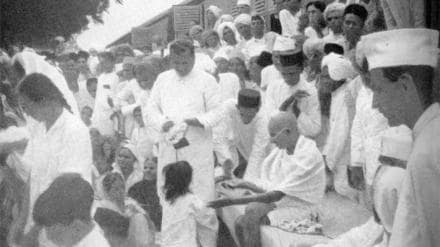‘It was Champaran that introduced me to India.’
Mahatma Gandhi in a letter to Miraben in 1921
Those words capture not only the depth of Mahatma Gandhi’s personal awakening in Bihar but also the beginning of a national transformation. On his birth anniversary today, as political currents run hot in poll-bound Bihar, Gandhiji’s Champaran connection reminds us how one of the most exploited corners of India became the cradle of ‘Satyagraha’.
Gandhiji steps into Indian politics from Bihar
When Gandhi returned from South Africa in 1915, he was still relatively unknown in Indian politics. But within two years, Champaran would change that forever. Responding to the relentless appeals of Rajkumar Shukla, an indigo cultivator from Bihar, Gandhiji set foot in Champaran’s Motihari district on April 17, 1917.
At the heart of Champaran’s misery was the infamous Tinkathia system. Under this exploitative practice, farmers were forced to cultivate indigo on a portion of their land, regardless of fertility or market demand. Even when synthetic dyes reduced indigo’s profitability in Europe, planters clung to the system and exploited the peasants.
Gandhiji arrived in Champaran and began listening to the plight of thousands of farmers. According to historical records, Gandhiji recorded testimonies of exploitation and abuse of around 8,000 farmers. His method was simple: to give voice to those long silenced. In doing so, he identified ignorance and illiteracy as twin chains of oppression.
The Champaran campaign
That diagnosis shaped the movement in unexpected ways. Gandhiji, along with Kasturba Gandhi, launched community education programmes in villages. Alongside Gandhiji stood a rising generation of leaders who would later shape independent India. Leaders like Rajendra Prasad, JB Kripalani, Narendra Dev, Gaya Babu and Brajkishore Prasad lent their weight to the Champaran campaign. They documented the agrarian crisis, spread awareness and built solidarity among peasants.
Champaran thus became not just Gandhiji’s entry into Indian politics but also a nursery of nationalist leadership.
The British administration, unnerved by Gandhiji’s growing influence, ordered him to leave Champaran. Gandhiji refused. His calm defiance shook colonial authority. For farmers who had never dared to resist, it was the first glimpse of a leader who stood beside them, not above them. Fear gave way to confidence and confidence to collective action.
Satyagraha
For perhaps the first time, India’s poorest realised they could challenge imperial authority without violence. The Britishers were cornered by the scale of mobilisation and Gandhiji’s international reputation. They established a commission of inquiry and included Gandhiji as one of its members. His presence ensured peasants’ testimonies were not buried under bureaucratic indifference.
The outcome was historic: the Champaran Agrarian Act of 1917, which abolished the Tinkathia system and ordered partial refunds of illegal dues.
Larger outcome of Champaran campaign
Champaran’s true legacy went beyond legal reform. It introduced India to a new mode of politics — one rooted in moral authority rather than armed might. It redefined leadership as service and struggle as a matter of truth and justice rather than vengeance.
In that sense, Champaran was not just a victory for Bihar’s farmers; it was a rehearsal for India’s larger freedom movement. Every subsequent Gandhian campaign — from Non-Cooperation to Quit India — carried echoes of the lessons learned in Champaran.
Today, when Bihar dominates headlines for its electoral battles and social churn, remembering Champaran is to recall a moment when the state gifted India its most powerful political weapon: Satyagraha.
